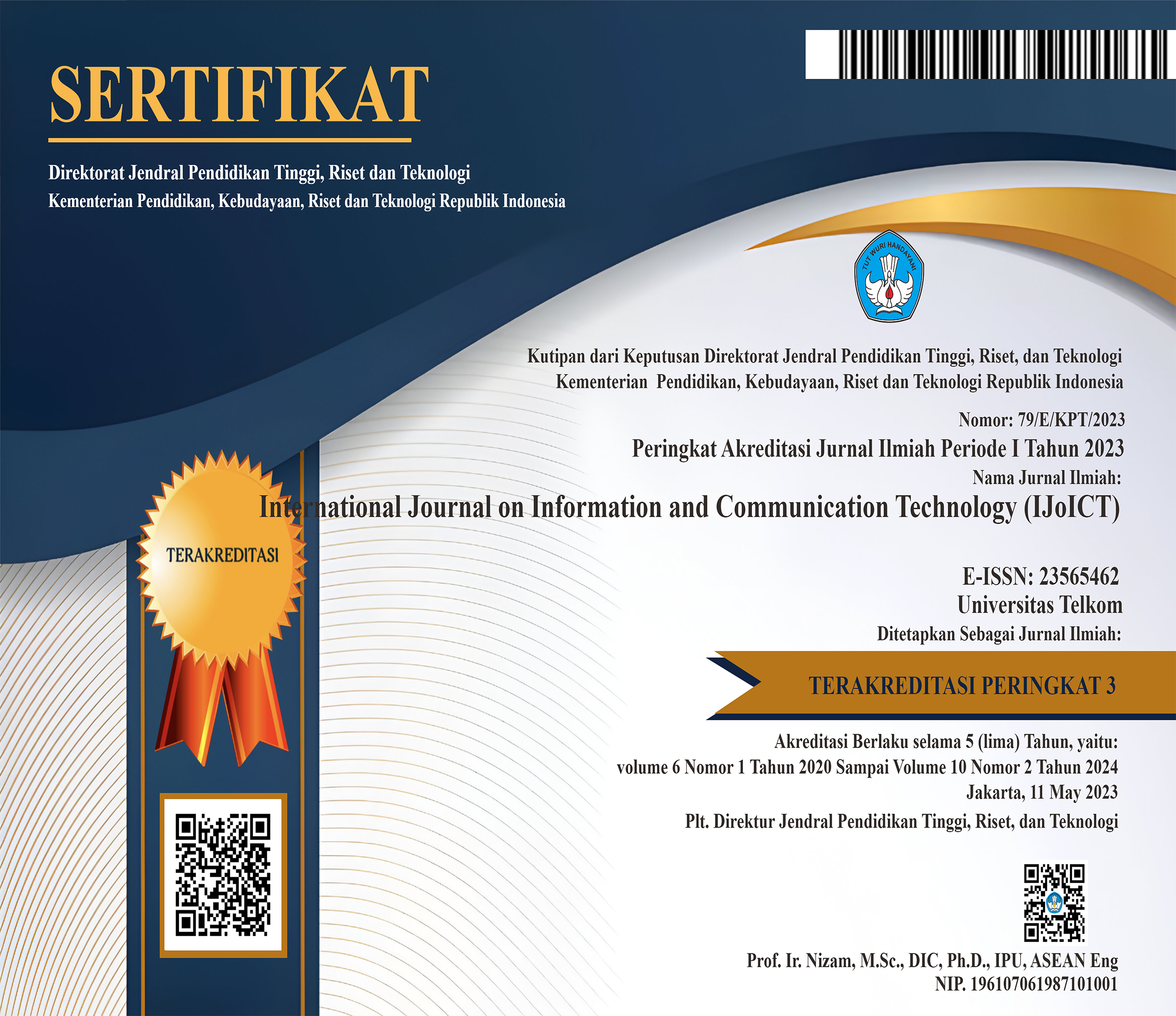The Analysis of Support Vector Machine (SVM) on Monthly Covid-19 Case Classification
 Abstract views: 504
,
Abstract views: 504
,
 pdf downloads: 257
pdf downloads: 257
Abstract
Covid-19 is disease caused by the new corona virus called Severe Acute Respiratory Syndrome Coronavirus 2 (SARS-CoV-2). The effect of this virus usually causes infection on respiratory system. Covid-19 was rapidly spread globally. Experts said that the factor that caused this to spread rapidly is human mobility. Therefore, several countries create new rules so that it can suppress the spreading of this disease, by prohibiting a large scale gathering, keeping away distance with each other, mandatory rule of using mask, and the prohibition for the entry of their country. This research proposes a performance analysis of Support Vector Machine (SVM) to classify the monthly data of covid-19. The data used in this research is a series of covid-19 data of towns in Bandung from November 2020 until December 2021. From conducting this research It is found that the best accuracy was found on December 2021 with the accuracy of 100%, followed by July and August with the accuracy of 97%, and October with the value of 90%. We can conclude that Support Vector Machine (SVM), is a good method on classifying the monthly covid-19 data.
Downloads
References
[2] S. Kim and M. C. Castro, “Spatiotemporal pattern of COVID-19 and government response in South Korea (as of May 31, 2020),†Int. J. Infect. Dis., vol. 98, pp. 328–333, 2020, doi: 10.1016/j.ijid.2020.07.004.
[3] R. K. Singh et al., “Prediction of the COVID-19 pandemic for the top 15 affected countries: Advanced autoregressive integrated moving average (ARIMA) model,†JMIR Public Heal. Surveill., vol. 6, no. 2, pp. 1–10, 2020, doi: 10.2196/19115.
[4] K. Yuki, M. Fujiogi, and S. Koutsogiannaki, “Since January 2020 Elsevier has created a COVID-19 resource centre with free information in English and Mandarin on the novel coronavirus COVID- 19 . The COVID-19 resource centre is hosted on Elsevier Connect , the company ’ s public news and information ,†no. January, 2020.
[5] D. Haritha, N. Swaroop, and M. Mounika, “Prediction of COVID-19 Cases Using CNN with X-rays,†Proc. 2020 Int. Conf. Comput. Commun. Secur. ICCCS 2020, 2020, doi: 10.1109/ICCCS49678.2020.9276753.
[6] C. C. da Silva et al., “Covid-19 Dynamic Monitoring and Real-Time Spatio-Temporal Forecasting,†Front. Public Heal., vol. 9, no. April, pp. 1–17, 2021, doi: 10.3389/fpubh.2021.641253.
[7] M. Alazab, A. Awajan, A. Mesleh, A. Abraham, V. Jatana, and S. Alhyari, “COVID-19 prediction and detection using deep learning,†Int. J. Comput. Inf. Syst. Ind. Manag. Appl., vol. 12, no. April, pp. 168–181, 2020.
[8] F. Tagliabue, L. Galassi, and P. Mariani, “The ‘Pandemic’ of Disinformation in COVID-19,†SN Compr. Clin. Med., vol. 2, no. 9, pp. 1287–1289, 2020, doi: 10.1007/s42399-020-00439-1.
[9] “COVID Live - Coronavirus Statistics - Worldometer.†https://www.worldometers.info/coronavirus/ (accessed Sep. 04, 2022).
[10] V. Singh et al., “Prediction of COVID-19 corona virus pandemic based on time series data using support vector machine,†J. Discret. Math. Sci. Cryptogr., vol. 23, no. 8, pp. 1583–1597, 2020, doi: 10.1080/09720529.2020.1784535.
[11] A. K. Dubey, S. Narang, A. Kumar, S. M. Sasubilli, and V. GarcÃa-DÃaz, “Performance estimation of machine learning algorithms in the factor analysis of COVID-19 dataset,†Comput. Mater. Contin., vol. 66, no. 2, pp. 1921–1936, 2020, doi: 10.32604/cmc.2020.012151.
[12] S. A. Kumar, H. Kumar, V. Dutt, and ..., “COVID-19 Pandemic analysis using SVM Classifier: Machine Learning in Health Domain,†Glob. J. …, vol. 4, no. 1, pp. 30–38, 2020, [Online]. Available: http://technology.eurekajournals.com/index.php/GJADSIT/article/view/637
[13] E. Fayyoumi, S. Idwan, and H. Aboshindi, “Machine learning and statistical modelling for prediction of Novel COVID-19 patients case study: Jordan,†Int. J. Adv. Comput. Sci. Appl., vol. 11, no. 5, pp. 122–126, 2020, doi: 10.14569/IJACSA.2020.0110518.
[14] C. N. Villavicencio, J. J. E. Macrohon, X. A. Inbaraj, J. H. Jeng, and J. G. Hsieh, “Covid-19 prediction applying supervised machine learning algorithms with comparative analysis using weka,†Algorithms, vol. 14, no. 7, 2021, doi: 10.3390/a14070201.
[15] H. R. Pourghasemi et al., “Spatial modeling, risk mapping, change detection, and outbreak trend analysis of coronavirus (COVID-19) in Iran (days between February 19 and June 14, 2020),†Int. J. Infect. Dis., vol. 98, pp. 90–108, 2020, doi: 10.1016/j.ijid.2020.06.058.
[16] S. Guhathakurata, S. Kundu, A. Chakraborty, and J. S. Banerjee, A novel approach to predict COVID-19 using support vector machine. Elsevier Inc., 2021. doi: 10.1016/B978-0-12-824536-1.00014-9.
[17] “Jumlah Penduduk Indonesia 271,4 Juta Jiwa pada 2020, Mayoritas di Jawa.†https://databoks.katadata.co.id/datapublish/2021/06/22/2714-juta-penduduk-ri-pada-2020-mayoritas-di-jawa (accessed Sep. 04, 2022).
[18] S. B. Kotsiantis and D. Kanellopoulos, “Data preprocessing for supervised leaning,†Int. J. …, vol. 1, no. 2, pp. 1–7, 2006, doi: 10.1080/02331931003692557.
[19] M. Buvana and K. Muthumayil, “Prediction of covid-19 patient using supervised machine learning algorithm,†Sains Malaysiana, vol. 50, no. 8, pp. 2479–2497, 2021, doi: 10.17576/jsm-2021-5008-28.
[20] S. Uddin, A. Khan, M. E. Hossain, and M. A. Moni, “Comparing different supervised machine learning algorithms for disease prediction,†BMC Med. Inform. Decis. Mak., vol. 19, no. 1, pp. 1–16, 2019, doi: 10.1186/s12911-019-1004-8.
[21] M. N. Ikechukwu, E. Ebinne, U. Idorenyin, and N. I. Raphael, “Accuracy Assessment and Comparative Analysis of IDW, Spline and Kriging in Spatial Interpolation of Landform (Topography): An Experimental Study,†J. Geogr. Inf. Syst., vol. 09, no. 03, pp. 354–371, 2017, doi: 10.4236/jgis.2017.93022.
[22] “Kasus Covid-19 Meningkat, Bandung 2 Pekan Masuk Zona Merah.†https://www.cnnindonesia.com/nasional/20201218224535-20-584094/kasus-covid-19-meningkat-bandung-2-pekan-masuk-zona-merah (accessed Sep. 04, 2022).
[23] “Kasus Corona Indonesia 611.631, Ini 5 Provinsi dengan Kasus Tertinggi Halaman all - Kompas.com.†https://www.kompas.com/tren/read/2020/12/13/124500065/kasus-corona-indonesia-611.631-ini-5-provinsi-dengan-kasus-tertinggi?page=all (accessed Sep. 04, 2022).
[24] H. Bhavsar and M. H. Panchal, “A Review on Support Vector Machine for Data Classification,†Int. J. Adv. Res. Comput. Eng. Technol., vol. 1, no. 10, pp. 2278–1323, 2012.
[25] A. Property and F. Extension, “Buzzer Detection on Indonesian Twitter using SVM and Account Property,†vol. 5, no. 158, pp. 663–669, 2022.

This work is licensed under a Creative Commons Attribution 4.0 International License.
Manuscript submitted to IJoICT has to be an original work of the author(s), contains no element of plagiarism, and has never been published or is not being considered for publication in other journals. Author(s) shall agree to assign all copyright of published article to IJoICT. Requests related to future re-use and re-publication of major or substantial parts of the article must be consulted with the editors of IJoICT.









.png)

.jpg)




